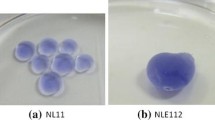Abstract
Purpose
To evaluate the potential usefulness of the balloon-occluded histoacryl glue embolization (B-glue) technique.
Materials and methods
Both flow-dependent (no balloon occlusion) and B-glue techniques were used for 24 intercostal arteries of two female swine. N-butyl 2-cyanoacrylate (NBCA) was diluted with lipiodol to a 50 % solution, which was infused after occluding the arteries with microballoon catheters. The embolization range, fragmentation, reflux, adhesion, and glue particle attachment were compared between flow-dependent and B-glue techniques.
Results
The B-glue technique was performed in a controlled fashion resulting in successful arterial occlusion without fragmented migration of the injected glue cast. Reflux occurred less frequently with the B-glue technique and was significantly different (p = 0.012) from that for the flow-dependent technique. Catheters were safely removed from the arterial walls, although in one instance (8.3 %), large glue particles were found to be attached to the catheter tip on removal. Conversely, the flow-dependent technique was more difficult to control and resulted in several instances of higher rates of fragmentation.
Conclusion
The B-glue technique can efficiently control NBCA delivery with lower rates of reflux.




Similar content being viewed by others
References
Mavili E, Donmez H, Ozcan N, Akcali Y. Endovascular treatment of lower limb penetrating arterial traumas. Cardiovasc Interv Radiol. 2007;30(6):1124–9.
Thomas A, Tomsick M, FACR, Investigators Tn-BT. N-butyl cyanoacrylate embolization of cerebral arteriovenous malformations: results of a prospective, randomized, multi-center trial. AJNR Am J Neuroradiol. 2002;23(5):748–55.
Kish JW, Katz MD, Marx MV, Harrell DS, Hanks SE. N-butyl cyanoacrylate embolization for control of acute arterial hemorrhage. J Vasc Interv Radiol. 2004;15(7):689–95.
Stoesslein F, Ditscherlein G, Romaniuk PA. Experimental studies on new liquid embolization mixtures (histoacryl-lipiodol, histoacryl-panthopaque). Cardiovasc Interv Radiol. 1982;5(5):264–7.
Maassen MS, Lambers MD, Tutein Nolthenius RP, van der Valk PH, Elgersma OE. Complications and failure of uterine artery embolisation for intractable postpartum haemorrhage. BJOG. 2009;116(1):55–61.
Soyer P, Morel O, Fargeaudou Y, Sirol M, Staub F, Boudiaf M, et al. Value of pelvic embolization in the management of severe postpartum hemorrhage due to placenta accreta, increta or percreta. Eur J Radiol. 2011;80(3):729–35.
Yoo DH, Jae HJ, Kim HC, Chung JW, Park JH. Transcatheter arterial embolization of intramuscular active hemorrhage with N-butyl cyanoacrylate. Cardiovasc Intervent Radiol. 2012;35(2):292–8.
Pollak JS, White RI Jr. The use of cyanoacrylate adhesives in peripheral embolization. J Vasc Interv Radiol. 2001;12(8):907–13.
Kanematsu M, Watanabe H, Kondo H, Goshima S, Kato H, Furui T, et al. Postpartum hemorrhage in coagulopathic patients: preliminary experience with uterine arterial embolization with N-butyl cyanoacrylate. J Vasc Interv Radiol. 2011;22(12):1773–6.
Frodsham A, Berkmen T, Ananian C, Fung A. Initial experience using N-butyl cyanoacrylate for embolization of lower gastrointestinal hemorrhage. J Vasc Interv Radiol. 2009;20(10):1312–9.
Igarashi S, Izuchi S, Ishizuka B, Yoshimatu M, Takizawa K. A case of pregnancy and childbirth after uterine artery embolization with a permanent embolic agent. Fertility and sterility. 2011;95(1):290 e9–11.
Yonemitsu T, Kawai N, Sato M, Tanihata H, Takasaka I, Nakai M, et al. Evaluation of transcatheter arterial embolization with gelatin sponge particles, microcoils, and N-butyl cyanoacrylate for acute arterial bleeding in a coagulopathic condition. J Vasc Interv Radiol. 2009;20(9):1176–87.
Nelson PK, Russell SM, Woo HH, Alastra AJ, Vidovich DV. Use of a wedged microcatheter for curative transarterial embolization of complex intracranial dural arteriovenous fistulas: indications, endovascular technique, and outcome in 21 patients. J Neurosurg. 2003;98(3):498–506.
Li MH, Tan HQ, Fang C, Zhu YQ, Wang W, Wang J, et al. Trans-arterial embolisation therapy of dural carotid-cavernous fistulae using low concentration N-butyl-cyanoacrylate. Acta Neurochir (Wien). 2008;150(11):1149–56 (discussion 56).
Razavi MK, Murphy K. Embolization of bronchial arteries with N-butyl cyanoacrylate for management of massive hemoptysis: a technical review. Tech Vasc Interv Radiol. 2007;10(4):276–82.
Iizuka Y, Maehara T, Hishii M, Miyajima M, Arai H. Successful transarterial glue embolisation by wedged technique for a tentorial dural arteriovenous fistula presenting with a conjunctival injection. Neuroradiology. 2001;43(8):677–9.
Hamaguchi S, Ogawa Y, Arai Y, Hashimoto K, Nakajima Y. A case of pseudoaneurysm of the deep femoral artery successfully treated by NBCA embolization under occlusion. Jpn J Radiol. 2013;31(8):538–41.
Acknowledgment
We would like to express many thanks to Prof. Kenji Takizawa, who first suggested this procedure, and would also like to extend our most sincere gratitude to Terumo Co. Clinical Supply, Gifu, Japan, who kindly provided us with the facility, animals, and ‘Attendant Delta’ microballoon catheters in order to conduct this independent comparative study.
Conflict of interest
The authors disclose that they have no conflicts of interest that could influence this report.
Author information
Authors and Affiliations
Corresponding author
About this article
Cite this article
Hamaguchi, S., Lohman, B.D., Ogawa, Y. et al. Preliminary findings of arterial embolization with balloon-occluded and flow-dependent histoacryl glue embolization in a swine model. Jpn J Radiol 33, 344–351 (2015). https://doi.org/10.1007/s11604-015-0426-1
Received:
Accepted:
Published:
Issue Date:
DOI: https://doi.org/10.1007/s11604-015-0426-1




